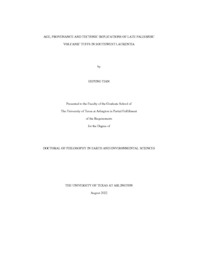
ATTENTION: The works hosted here are being migrated to a new repository that will consolidate resources, improve discoverability, and better show UTA's research impact on the global community. We will update authors as the migration progresses. Please see MavMatrix for more information.
Show simple item record
| dc.contributor.advisor | Fan, Majie | |
| dc.creator | Tian, Hepeng | |
| dc.date.accessioned | 2022-09-15T14:05:10Z | |
| dc.date.available | 2022-09-15T14:05:10Z | |
| dc.date.created | 2022-08 | |
| dc.date.issued | 2022-08-17 | |
| dc.date.submitted | August 2022 | |
| dc.identifier.uri | http://hdl.handle.net/10106/30981 | |
| dc.description.abstract | Assembly of the supercontinent Pangea is among the most important tectonic events in late Paleozoic Earth history. The diachronous Laurentia-Gondwana collision destroyed the intervening subduction zone(s) of the Rheic oceanic plate, ultimately leading to subduction of the Paleo-Pacific oceanic plate beneath western Pangea. However, details about the timing, nature, and geochemical signatures of the two arc systems during the transition from Rheic oceanic plate to Paleo-Pacific oceanic plate subduction are poorly understood. This lack of understanding, in part, reflects the fact that arc magmatic products (esp. granitic rocks) related to the Rheic ocean subduction are largely obscured by those related to the eastward subduction of the Paleo-Pacific oceanic plate beneath western Pangea together with the subsequent Pangea breakup, including deep burial, and erosion. Herein I study bulk tuff major and trace element geochemistry, and zircon U-Pb LA-ICP-MS and CA-ID-TIMS geochronology, Lu-Hf isotope and trace element compositions of ten well-preserved volcanic tuff units distributed in southwest Laurentia to reconstruct the tectonic sequence related to the final Pangea assembly. The tuff units include five Stanley tuffs from the Ouachita Mountains of southeastern Oklahoma and southwestern Arkansas, five tuffs from the subsurface of the Permian Basin in western Texas and eastern New Mexico, and three tuffs in the Glass Mountains in western Texas. The results show that the tuffs, ranging in age from Late Mississippian (327.8 ±0.8 Ma) to Guadalupian (266.5 ±0.1 Ma), originated from continental arcs with granitoid parent magma composition. The Mississippian Barnett and Stanley tuffs have primitive zircon ℇHf values (0 to +5) similar to granitoids of the Maya block in northern Gondwana, suggesting that the tuffs were derived from volcanoes resulting from subduction of the Rheic oceanic plate. A rapid change of ℇHf signature occurred between the Cisuralian Wolfcamp B tuff (288.2 ±1.7 Ma), which has an average zircon ℇHf value (+5.5), similar to the Barnett and Stanley tuffs, and the Wolfcamp A tuff (287.2 ±0.5) that has an evolved average ℇHf value (-4.5). The rapid change within one Myr most likely reflects termination of the northern Gondwana arc following the assembly of Pangea and initiation of magmatism related to subduction of the paleo-Pacific oceanic plate beneath western Pangea. Results of this study show the arc signature became progressively more primitive from the late Cisuralian to Guadalupian between ca. 282 Ma and ca. 260 Ma. | |
| dc.format.mimetype | application/pdf | |
| dc.language.iso | en_US | |
| dc.subject | Permian basin | |
| dc.subject | Zircon TIMS dating | |
| dc.subject | Zircon LA-ICPMS dating | |
| dc.subject | Pangea assembly | |
| dc.subject | Volcanic tuff absolute date | |
| dc.subject | Tectonics | |
| dc.title | AGE, PROVENANCE AND TECTONIC IMPLICATIONS OF LATE PALEOZOIC VOLCANIC TUFFS IN SOUTHWEST LAURENTIA | |
| dc.type | Thesis | |
| dc.degree.department | Earth and Environmental Sciences | |
| dc.degree.name | Doctor of Philosophy in Earth and Environmental Science | |
| dc.date.updated | 2022-09-15T14:05:10Z | |
| thesis.degree.department | Earth and Environmental Sciences | |
| thesis.degree.grantor | The University of Texas at Arlington | |
| thesis.degree.level | Doctoral | |
| thesis.degree.name | Doctor of Philosophy in Earth and Environmental Science | |
| dc.type.material | text | |
Files in this item
- Name:
- TIAN-DISSERTATION-2022.pdf
- Size:
- 7.954Mb
- Format:
- PDF
This item appears in the following Collection(s)
Show simple item record


